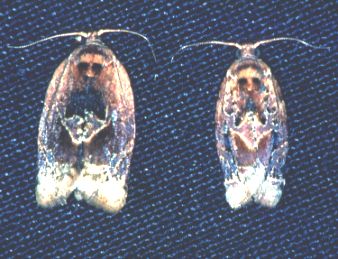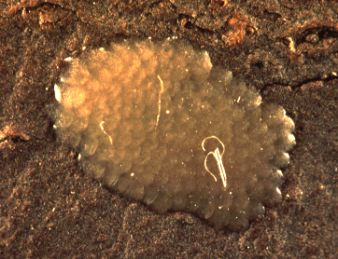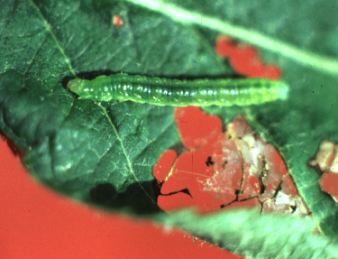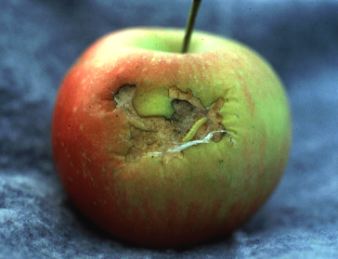 Redbanded Leafroller, Argyrotaenia
velutinana
Walker
Redbanded Leafroller, Argyrotaenia
velutinana
Walker
I. Introduction: Redbanded leafroller
(RBLR)
was once the most important leafroller in the eastern
U.S., reaching its greatest severity in the mid-Atlantic states.
Although occasional outbreaks occurred
early in the century, this species rose to its greatest pest
status
after the introduction of DDT. It is
generally controlled by growers using conventional
organophosphate-based spray programs, but occasional
outbreaks still occur.
II. Hosts: In addition to apple, RBLR has been a pest of
cherry,
peach, plum, grape and other
small fruits, and ornamental crops. This species has a broad host
range, tying leaves of most plant species
except conifers.
III. Description: The adults are easily distinguished by
the
presence of rusty red or red-brown bands
extending from about the middle of the front edge of the wing
(outer
edge when folded) to a point about
two-thirds of the distance from the wing base on the rear edge
(inner
edge when folded). This band forms
a V-shape when at rest (Plate 22). There is a patch of similar
colored
scales forming a spot at the front
edge of the wing, about 3/4 of the length from the wing base.
There is
a concentration of creamy-colored
scales in the outer quarter of the forewing. There is substantial
variation in the intensity of color of
RBLR, more so than most leafrollers. Male wingspan is about 1/2
inch
(13 mm), that of females is about 6/10
inch (16 mm). Larvae are fairly uniform green with a green head
capsule
(Plate 23), reaching a length of
about 7/10 inch (17 mm) (14-18 mm in the female, 13-17 mm in the
male).
If larvae have fed on fruit, they
develop a yellow tint (Plate 24). Pupae are deep brown, reaching a
length of about 3/10 inch (7-8 mm).


IV. Biology: RBLR has four generations in Virginia, but
only two
in the northern part of its range
(e.g. New York). Pupae overwinter in the ground cover (in rare
cases,
larvae will survive the winter). In
the mid-Atlantic region, adults start to fly around green tip. The
peak
of the first flight occurs from
tight cluster to pink. Females lay eggs primarily on the trunk and
scaffold limbs, mainly at pink, averaging
40-45 eggs/mass for the spring brood, 60-80 for later broods. Egg
masses have a gray-green to dull yellow-orange
color (Plate 25). Larger masses are about 1/10 x 2/10 inch (3x5
mm).
First generation eggs hatch about late
bloom or petal-fall. Larvae of this generation are present from
early
May to mid June. Adults emerge after a
pupal period of about 8 days. There is a 1-7 day pre-ovipositional
period (averaging 2-3 days). Adult males
live 6-10 days on average, females 7-10 days. In Virginia, first
male
captures (peak catch in parentheses) of
the four flights were early April (mid-April), late May
(mid-June),
early July (mid-July), and late August
(mid-September).
Eggs are parasitized by Trichogramma minutum Riley, and a
complex of parasites attack larvae and pupae.
Larvae are subject to infection by a granulosis virus.
V. Injury: First generation larvae feed mainly on leaves,
but
fruit feeding can result in deeply
scarred fruit at harvest. Early generation injury may be a broad
irregular scar on the side of the fruit. Later
generation injury consists of several interconnected feeding
areas,
forming a broad, shallow wound, at times
reaching 1 inch (25 mm) across. Larvae may form webbing at the
calyx.
Larvae may feed either in the calyx or
the side of the fruit.

VI. Monitoring: Adults may be monitored beginning around
green
tip. Place pheromone traps in the
orchard and check weekly. Larvae may be monitored by searching for
tied
leaves. Injured fruit should be
assessed periodically through the season. No thresholds are
available
based on pheromone trap catch. A
provisional economic threshold is 1% injured fruit at harvest.
This is taken primarily from a chapter by L.
A.
Hull, D. G. Pfeiffer & D. J. Biddinger on apple direct pests,
reprinted with permission from Mid-Atlantic Orchard Monitoring
Guide,
published
by
NRAES,
152
Riley-Robb Hall, Ithaca, New York 14853-5701.
Back to Virginia
Apple
Page
Back to Home Page for "Arthropod Management
in
Fruit Crops" course
Back to Virginia Fruit
Page
 Redbanded Leafroller, Argyrotaenia
velutinana
Walker
Redbanded Leafroller, Argyrotaenia
velutinana
Walker


